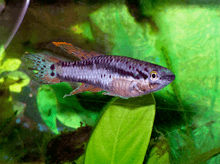Aphyosemion bivittatum
Aphyosemion bivittatum (twostripe lyretail, two-banded killi, red lyretail) is a species of freshwater fish belonging to the family Aplocheilidae. It is found in rivers in southeastern Nigeria and southwestern Cameroon.[2] It was originally described as Fundulus bivittatus by Swedish zoologist Einar Lönnberg in 1895. The holotype was discovered near a waterfall in the Ndian River in Cameroon and currently is located in the Stockholm Museum.[3]
| Aphyosemion bivittatum | |
|---|---|
 | |
| Aphyosemion bivittatum Male | |
| Scientific classification | |
| Kingdom: | Animalia |
| Phylum: | Chordata |
| Class: | Actinopterygii |
| Order: | Cyprinodontiformes |
| Family: | Nothobranchiidae |
| Genus: | Aphyosemion |
| Species: | A. bivittatum |
| Binomial name | |
| Aphyosemion bivittatum (Lönnberg, 1895) | |
| Synonyms[2] | |
| |
Appearance
A. bivittatum has an elongated, brightly coloured body with two dark bands made up of red spots running along each side, with the colors varying between populations.[4] Individual males are commonly found with golden-brown dorsal surfaces, bluish sides, and golden ventral surfaces.[4] The males have a maximum body length of approximately 5 centimetres (2.0 in) and have brightly marked, tall and pointed anal and dorsal fins that are yellow to pastel green with red edges.[4] The caudal and dorsal fins are green with red spots and bright yellow tips.[4] It has 10–13 spines in its dorsal fin and 12–15 in its anal fin.[5]
Habitat
The species is found in small calcium rich steams in the coastal rainforests of southeastern Nigeria and southwestern Cameroon. They are benthopelagic, meaning they float just above the riverbed.[1] They prefer water with a pH of 6 to 6.5 and temperature of 22 to 24 °C (72 to 75 °F).[6][2]
References
- Olaosebikan, B.D. (2020). "Aphyosemion bivittatum". IUCN Red List of Threatened Species. 2020: e.T181757A134751405. Retrieved 17 July 2020.
- "Aphyosemion bivittatum (Lönnberg, 1895)". Fish Base. Retrieved 16 October 2016.
- "Aphyosemiom bivittatum (Lönnberg 1895)". Killifish of Western Africa. Retrieved 16 October 2016.
- Butler, Rhett. "Two Stripe Killifish Aphyosemion bivittatum". Mongabay.com. Retrieved 16 October 2016.
- Huber, J.H. (1996). "Killi-Data 1996. Updated checklist of taxonomic names, collecting localities and bibliographic references of oviparous Cyprinodont fishes (Atherinomorpha, Pisces)". Société Française d'Ichtyologie, Muséum National d'Histoire Naturelle: 399.
- Riehl, R.; H.A. Baensch (1991). Aquarien Atlas Volume 1. Germany: Melle: Mergus, Verlag für Natur-und Heimtierkunde. p. 992.
External links

